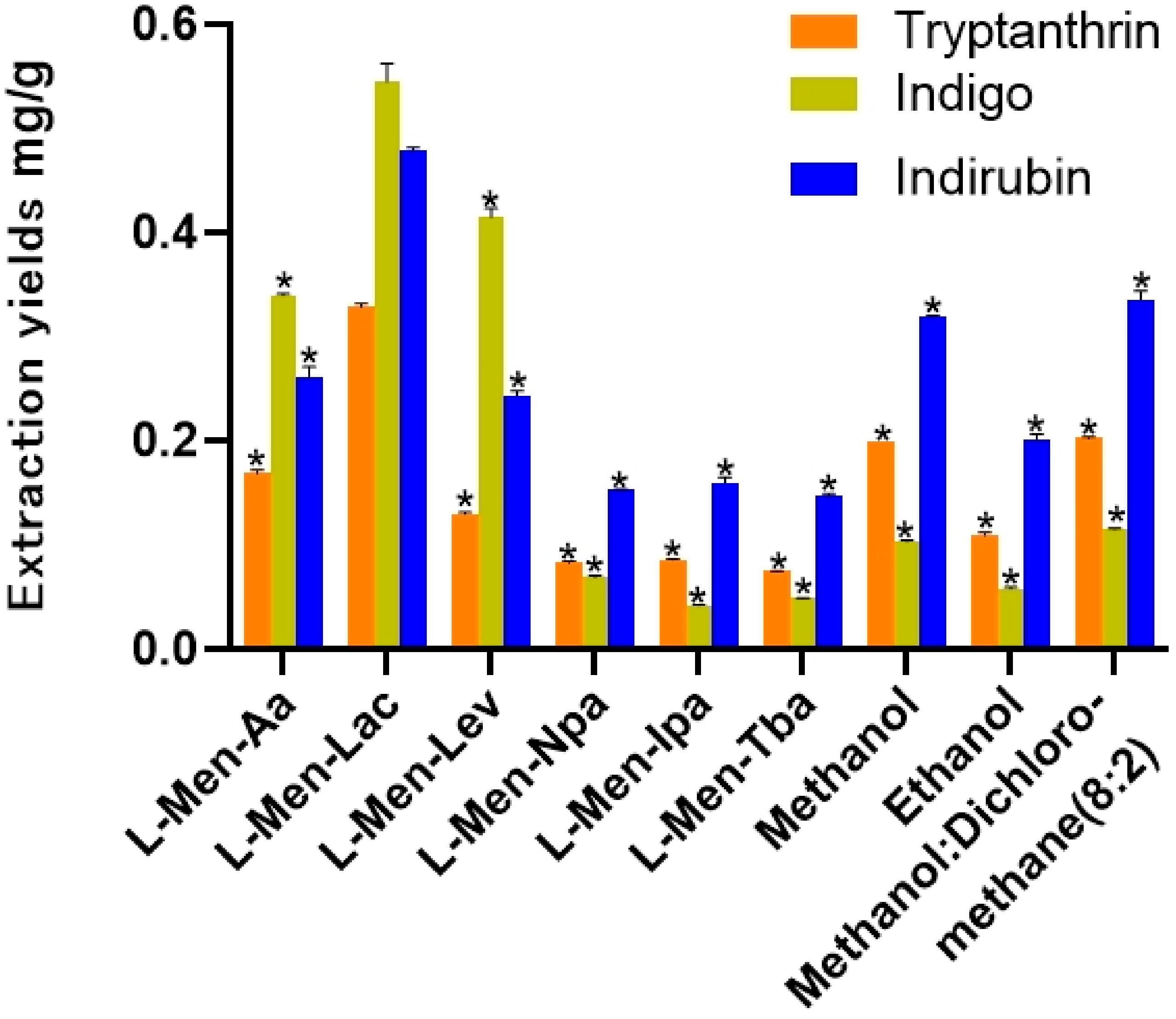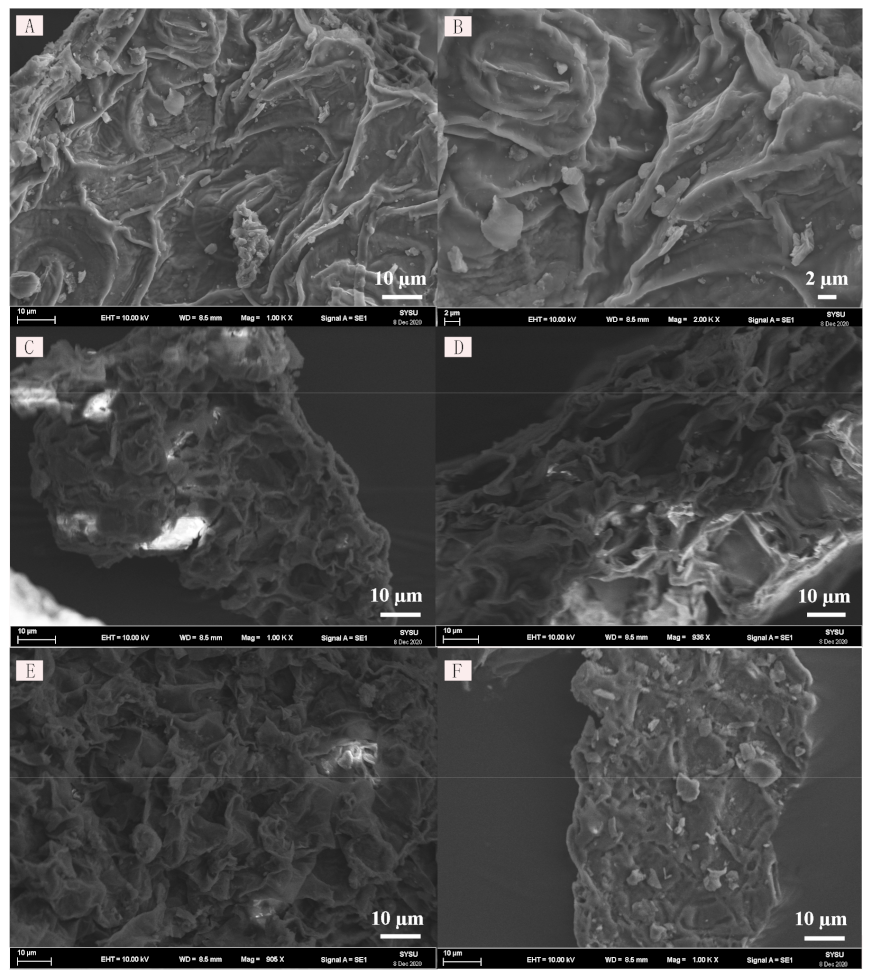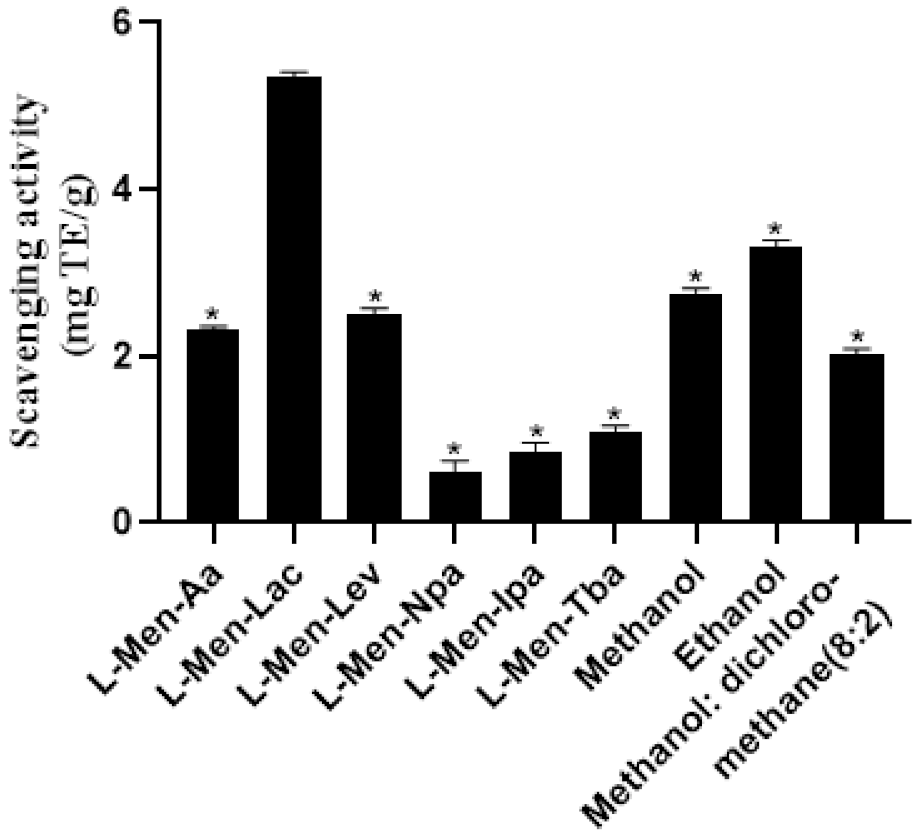Optimization of Extraction of Bioactive Compounds from Baphicacanthus cusia Leaves by Hydrophobic Deep Eutectic Solvents
Abstract
:1. Introduction
2. Results and Discussion
2.1. Evaluation of DES Extraction Efficiency
2.2. Fourier-Transform Infrared Spectroscopy (FT-IR) Analysis of L-Men-Lac
2.3. Optimization of the Extraction Parameters by RSM
1.033 × 10−5BC − 4.125 × 10−4A2 + 9.444 × 10−7B2 + 8.16 × 10−6C2
2.093 × 10−4BC − 0.033A2 − 1.624 × 10−4B2 − 7.203 × 10−4C2
2.093 × 10−4BC − 0.033A2 − 1.624 × 10−4B2 − 7.203 × 10−4C2
2.4. DPPH Radical Scavenging Activities of DES Extracts
3. Materials and Methods
3.1. Materials Reagents and Equipment
3.2. Preparation of DES
3.3. Extraction Procedure
3.4. Morphological Characterization Observation of BCL by Scanning Electron Microscope (SEM)
3.5. FT-IR Measurements
3.6. Characterization and Quantification of Extracted Compounds
3.7. Determination of Antioxidant Capacity
4. Conclusions
Supplementary Materials
Author Contributions
Funding
Institutional Review Board Statement
Informed Consent Statement
Data Availability Statement
Conflicts of Interest
Sample Availability
References
- Zhu, L.; Cao, F.; Su, X.; Li, C.; Lin, B.; Wang, H.; Yao, X.; Zhang, X.; Jia, J.; Liu, H. Baphicacanthcusines A-E, bisindole alkaloids from the leaves of Baphicacanthus cusia (Nees) Bremek. J. Org. Chem. 2020, 85, 8580–8587. [Google Scholar] [CrossRef]
- Lin, W.; Huang, W.; Ning, S.; Gong, X.; Ye, Q.; Wei, D. Comparative transcriptome analyses revealed differential strategies of roots and leaves from methyl jasmonate treatment Baphicacanthus cusia (Nees) Bremek and differentially expressed genes involved in tryptophan biosynthesis. PLoS ONE 2019, 14, e0212863. [Google Scholar] [CrossRef] [PubMed]
- Qin, J.; Chen, Y.; Zhang, D.; Cao, M. Study on the content of indirubin in the leaves of Baphicacanthus cusia (Nees) Bremek. in different illumination intensities. Med. Plant 2014, 5, 9–11. [Google Scholar]
- Zhao, X.; He, X.; Zhong, X. Anti-inflammatory and in-vitro antibacterial activities of Traditional Chinese Medicine Formula Qingdaisan. BMC Complement. Altern. Med. 2016, 16, 503. [Google Scholar] [CrossRef] [PubMed] [Green Version]
- Li, H.; Liu, L.; Liu, C.; Zhuang, J.; Zhou, C.; Yang, J.; Gao, C.; Liu, G.; Lv, Q.; Sun, C. Deciphering key pharmacological pathways of qingdai acting on chronic myeloid leukemia using a network pharmacology-based strategy. Med. Sci. Monit. 2018, 15, 5668–5688. [Google Scholar] [CrossRef]
- Kawai, S.; Iijima, H.; Shinzaki, S.; Hiyama, S.; Yamaguchi, T.; Araki, M.; Iwatani, S.; Shiraishi, E.; Mukai, A.; Inoue, T.; et al. Indigo Naturalis ameliorates murine dextran sodium sulfate-induced colitis via aryl hydrocarbon receptor activation. J. Gastroenterol. 2017, 52, 904–919. [Google Scholar] [CrossRef]
- Lin, Y.K.; See, L.C.; Huang, Y.H.; Chi, C.C.; Hui, R.C.Y. Comparison of indirubin concentrations in indigo naturalis ointment for psoriasis treatment: A randomized, double-blind, dosage-controlled trial. Br. J. Dermatol. 2018, 178, 124–131. [Google Scholar] [CrossRef] [PubMed]
- Tsai, Y.; Lee, C.; Yen, H.; Chang, Y.; Lin, Y.; Huang, S.; Lin, C. Antiviral action of tryptanthrin isolated from Strobilanthes cusia leaf against Human coronavirus NL63. Biomolecules 2020, 10, 366. [Google Scholar] [CrossRef] [PubMed] [Green Version]
- Kawakami, J.; Matsushima, N.; Ogawa, Y.; Kakinami, H.; Nakane, A.; Kitahara, H.; Nagaki, M.; Ito, S. Antibacterial and antifungal activities of tryptanthrin derivatives. Trans. Mater. Res. Soc. Japan 2011, 36, 603–606. [Google Scholar] [CrossRef] [Green Version]
- Zeng, Q.; Luo, C.; Cho, J.; Lai, D.; Shen, X.; Zhang, X.; Zhou, W. Tryptanthrin exerts anti-breast cancer effects both in vitro and in vivo through modulating the inflammatory tumor microenvironment. Acta Pharm. 2021, 71, 245–266. [Google Scholar] [CrossRef]
- Cheng, H.; Kuo, Y.; Chang, C.; Chang, C.; Fang, W.; Chang, C.; Pan, S.; Lin, J.; Wu, L. The anti-TH17 polarization effect of Indigo naturalis and tryptanthrin by differentially inhibiting cytokine expression. J. Ethnopharmacol. 2020, 255, 112760. [Google Scholar] [CrossRef]
- Kaur, R.; Manjal, S.K.; Rawal, R.K.; Kumar, K. Recent synthetic and medicinal perspectives of tryptanthrin. Bioorg. Med. Chem. 2017, 25, 4533–4552. [Google Scholar] [CrossRef] [PubMed]
- Mak, N.; Leung, C.; Wei, X.; Shen, X.; Wong, R.N.; Leung, K.; Fung, M. Inhibition of RANTES expression by indirubin in influenza virus-infected human bronchial epithelial cells. Biochem. Pharmacol. 2004, 67, 167–174. [Google Scholar] [CrossRef]
- Qi, T.; Li, H.; Li, S. Indirubin improves antioxidant and anti-inflammatory functions in lipopolysaccharide-challenged mice. Oncotarget 2017, 8, 36658–36663. [Google Scholar] [CrossRef] [PubMed] [Green Version]
- Zhao, G.; Li, T.; Qu, X.; Zhang, N.; Lu, M.; Wang, J. Optimization of ultrasound-assisted extraction of indigo and indirubin from Isatis indigotica Fort. and their antioxidant capacities. Food Sci. Biotechnol. 2017, 26, 1313–1323. [Google Scholar] [CrossRef] [PubMed]
- Andreazza, N.L.; de Lourenço, C.C.; Stefanello, M.É.A.; Atvars, T.D.Z.; Salvador, M.J. Photodynamic antimicrobial effects of bis-indole alkaloid indigo from Indigofera truxillensis Kunth (Leguminosae). Laser Med. Sci. 2015, 30, 1315–1324. [Google Scholar] [CrossRef]
- Wang, T.; Zeng, Y.Y.; Zhao, J.X.; Hu, Y.J.; Jiang, X.; Di, J.F.; Feng, Z. Effects of indigo blue and indirubin on activation and proliferation of mouce T lymphocytes. J. Chin. Pharm. Univ. 2005, 36, 444–447. [Google Scholar]
- Liau, B.C.; Jong, T.T.; Lee, M.R.; Chen, S.S. LC-APCI-MS method for detection and analysis of tryptanthrin, indigo, and indirubin in Daqingye and Banlangen. J. Pharm. Biomed. Anal. 2007, 43, 346–351. [Google Scholar] [CrossRef]
- Hou, H.C.; Liang, S.Z. Determination of indirubin and indigo in Baphicacanthus cusia (Nees) Bremek by HPLC. Chin. Med. Mat. 2006, 29, 681–682. [Google Scholar]
- Abbott, A.P.; Capper, G.; Davies, D.L.; Rasheed, R.K.; Tambyrajah, V. Novel solvent properties of choline chloride/urea mixtures. Chem. Commun. 2003, 9, 70–71. [Google Scholar] [CrossRef] [PubMed] [Green Version]
- Smith, E.L.; Abbott, A.P.; Ryder, K.S. Deep eutectic solvents (DESs) and their applications. Chem. Rev. 2014, 114, 11060–11082. [Google Scholar] [CrossRef] [Green Version]
- Li, X.; Row, K.H. Development of deep eutectic solvents applied in extraction and separation. J. Sep. Sci. 2016, 39, 3505–3520. [Google Scholar] [CrossRef] [PubMed]
- Zainal-Abidin, M.H.; Hayyan, M.; Hayyan, A.; Jayakumar, N.S. New horizons in the extraction of bioactive compounds using deep eutectic solvents: A review. Anal. Chim. Acta 2017, 979, 1–23. [Google Scholar] [CrossRef]
- Peng, X.; Duan, M.; Yao, X.; Zhang, Y.; Zhao, C.; Zu, Y.; Fu, Y. Green extraction of five target phenolic acids from Lonicerae japonicae Flos with deep eutectic solvent. Sep. Purif. Technol. 2016, 157, 249–257. [Google Scholar] [CrossRef]
- Xia, B.; Yan, D.; Bai, Y.; Xie, J.; Cao, Y.; Liao, D.; Lin, L. Determination of phenolic acids in Prunella vulgaris L.: A safe and green extraction method using alcohol-based deep eutectic solvents. Anal. Methods UK 2015, 7, 9354–9364. [Google Scholar] [CrossRef]
- Cvjetko Bubalo, M.; Ćurko, N.; Tomašević, M.; Kovačević Ganić, K.; Radojčić Redovniković, I. Green extraction of grape skin phenolics by using deep eutectic solvents. Food Chem. 2016, 200, 159–166. [Google Scholar] [CrossRef]
- Cui, Q.; Peng, X.; Yao, X.; Wei, Z.; Luo, M.; Wang, W.; Zhao, C.; Fu, Y.; Zu, Y. Deep eutectic solvent-based microwave-assisted extraction of genistin, genistein and apigenin from pigeon pea roots. Sep. Purif. Technol. 2015, 150, 63–72. [Google Scholar] [CrossRef]
- He, X.; Yang, J.; Huang, Y.; Zhang, Y.; Wan, H.; Li, C. Green and efficient ultrasonic-assisted extraction of bioactive components from Salvia miltiorrhiza by natural deep eutectic solvents. Molecules 2020, 25, 140. [Google Scholar] [CrossRef] [Green Version]
- Li, Y.; Hsieh, Y.H.; Pan, Z.; Zhang, L.; Yu, W.; Wang, B.; Zhang, J. Extraction of alkaloids from coptidis rhizoma via betaine-based deep eutectic solvents. ChemistrySelect (Weinheim) 2020, 5, 4973–4978. [Google Scholar] [CrossRef]
- Li, Y.; Pan, Z.; Wang, B.; Yu, W.; Song, S.; Feng, H.; Zhao, W.; Zhang, J. Ultrasound-assisted extraction of bioactive alkaloids from Phellodendri amurensis cortex using deep eutectic solvent aqueous solutions. New J. Chem. 2020, 44, 9172–9178. [Google Scholar] [CrossRef]
- Van Osch, D.J.G.P.; Zubeir, L.F.; Den Bruinhorst, A.; Rocha, M.A.A.; Kroon, M.C. Hydrophobic deep eutectic solvents as water-immiscible extractants. Green Chem. 2015, 17, 4518–4521. [Google Scholar] [CrossRef] [Green Version]
- Fan, X.; Chang, Y.; Wang, L.; Zhu, Y.; Dong, M.; Lv, M.; An, J.; Yang, Q.; Jiao, J.; Meng, D.; et al. A simple and efficient sample preparation for taxanes in Taxus chinensis needles with natural menthol-based aqueous deep eutectic solvent. J. Sep. Sci. 2020, 43, 1339–1347. [Google Scholar] [CrossRef] [PubMed]
- Wang, L.; Yang, Q.; Cui, Q.; Fan, X.; Dong, M.; Gao, M.; Lv, M.; An, J.; Meng, D.; Zhao, X.; et al. Recyclable menthol-based deep eutectic solvent micellar system for extracting phytochemicals from Ginkgo biloba leaves. J. Clean. Prod. 2020, 244, 118648. [Google Scholar] [CrossRef]
- Liu, J.; Fu, S.; Wei, N.; Hou, Y.; Zhang, X.; Cui, H. The effects of combined menthol and borneol on fluconazole permeation through the cornea ex vivo. Eur. J. Pharmacol. 2012, 688, 1–5. [Google Scholar] [CrossRef] [PubMed]
- Alammar, A.; Park, S.; Ibrahim, I.; Arun, D.; Holtzl, T.; Dumée, L.F.; Lim, H.N.; Szekely, G. Architecting neonicotinoid-scavenging nanocomposite hydrogels for environmental remediation. Appl Mater Today 2020, 21, 100878. [Google Scholar] [CrossRef]
- Kritchenkov, A.S.; Kletskov, A.V.; Egorov, A.R.; Tskhovrebov, A.G.; Kurliuk, A.V.; Zhaliazniak, N.V.; Shakola, T.V.; Khrustalev, V.N. New water-soluble chitin derivative with high antibacterial properties for potential application in active food coatings. Food Chem. 2021, 343, 128696. [Google Scholar] [CrossRef] [PubMed]
- Giannakoudakis, D.A.; Łomota, D.; Colmenares, J.C. When sonochemistry meets heterogeneous photocatalysis: Designing a sonophotoreactor towards sustainable selective oxidation. Green Chem. 2020, 15, 4896–4905. [Google Scholar] [CrossRef]
- Bernardi, S.; Lupatini-Menegotto, A.L.; Kalschne, D.L.; Moraes Flores, É.L.; Bittencourt, P.R.S.; Colla, E.; Canan, C. Ultrasound: A suitable technology to improve the extraction and techno-functional properties of vegetable food proteins. Plant Foods Hum. Nutr. 2021. [Google Scholar] [CrossRef] [PubMed]
- Yu, C.H.; Wu, Q.F.; Sheng, Z.H.; Zeng, X.Y.; Liu, D.H. Study on the extraction of indirubin from Isatis indigotica Fort. Chin. Med. Mater. 2006, 29, 721–723. [Google Scholar]
- Bi, W.; Tian, M.; Row, K.H. Evaluation of alcohol-based deep eutectic solvent in extraction and determination of flavonoids with response surface methodology optimization. J. Chromatogr. A 2013, 1285, 22–30. [Google Scholar] [CrossRef] [PubMed]
- Jin, Y.; Jung, D.; Li, K.; Park, K.; Lee, J. Mixing of menthol-based hydrophobic deep eutectic solvents as a novel method to tune their properties. J. Mol. Liq. 2020, 301, 112416. [Google Scholar] [CrossRef]
- Křížek, T.; Bursová, M.; Čabala, R.; Hložek, T.; Horsley, R.; Kuchař, M.; Tůma, P. Menthol-based hydrophobic deep eutectic solvents towards greener and efficient extraction of phytocannabinoids. J. Clean. Prod. 2018, 193, 391–396. [Google Scholar] [CrossRef]
- Silva, Y.P.A.; Ferreira, T.A.P.C.; Jiao, G.; Brooks, M.S. Sustainable approach for lycopene extraction from tomato processing by-product using hydrophobic eutectic solvents. J. Food. Sci. Technol. 2019, 56, 1649–1654. [Google Scholar] [CrossRef] [PubMed]
- Ribeiro, B.D.; Florindo, C.; Iff, L.C.; Coelho, M.A.Z.; Marrucho, I.M. Menthol-based eutectic mixtures: Hydrophobic low viscosity solvents. ACS Sustain. Chem. Eng. 2015, 3, 2469–2477. [Google Scholar] [CrossRef]
- Jeong, K.M.; Lee, M.S.; Nam, M.W.; Zhao, J.; Jin, Y.; Lee, D.; Kwon, S.W.; Jeong, J.H.; Lee, J. Tailoring and recycling of deep eutectic solvents as sustainable and efficient extraction media. J. Chromatogr. A 2015, 1424, 10–17. [Google Scholar] [CrossRef] [PubMed]
- Nam, M.W.; Zhao, J.; Lee, M.S.; Jeong, J.H.; Lee, J. Enhanced extraction of bioactive natural products using tailor-made deep eutectic solvents: Application to flavonoid extraction from Flos sophorae. Green Chem. 2015, 3, 1718–1727. [Google Scholar] [CrossRef]
- Wang, T.; Wang, Q.; Li, P.; Yang, H. High-Speed Countercurrent Chromatography-Based Method for Simultaneous Recovery and Separation of Natural Products from Deep Eutectic Solvent Extracts. ACS Sustain. Chem. Eng. 2020, 8, 2073–2080. [Google Scholar] [CrossRef]






| No. | Abbreviation | Type of HBA | Type of HBD | Molar Ratio | Appearance at Room Temperature |
|---|---|---|---|---|---|
| 1 | L-Men-Aa | L-Menthol | Acetic acid | 1:1 | Transparent liquid |
| 2 | L-Men-Lac | L-Menthol | Lactic acid | 1:1 | Transparent liquid |
| 3 | L-Men-Lev | L-Menthol | Levulinic acid | 1:1 | Transparent yellow liquid |
| 4 | L-Men-Npa | L-Menthol | n-Propanol | 1:1 | Transparent liquid |
| 5 | L-Men-Ipa | L-Menthol | Isopropanol | 1:2 | Transparent liquid |
| 6 | L-Men-Tba | L-Menthol | tert-Butanol | 1:2 | Transparent liquid |
| Levels | Independent Variables | ||
|---|---|---|---|
| A (HBD–HBA Molar Ratio) | B (Liquid–Solid Ratio, mL/g) | C (Temperature, ℃) | |
| −1 | 1 | 20 | 25 |
| 0 | 3 | 50 | 50 |
| 1 | 5 | 80 | 75 |
| Run | Factors | Extraction Yields | ||||
|---|---|---|---|---|---|---|
| A (HBD–HBA Molar Ratio) | B (Liquid–Solid Ratio, mL/g) | C (Temperature, ℃) | Tryptanthrin (mg/g) | Indigo (mg/g) | Indirubin (mg/g) | |
| 1 | 3 | 50 | 50 | 0.344 | 1.727 | 0.571 |
| 2 | 3 | 20 | 25 | 0.305 | 0.542 | 0.460 |
| 3 | 3 | 80 | 75 | 0.371 | 1.078 | 0.571 |
| 4 | 3 | 50 | 50 | 0.334 | 1.720 | 0.551 |
| 5 | 5 | 50 | 75 | 0.364 | 0.912 | 0.569 |
| 6 | 1 | 50 | 25 | 0.320 | 1.038 | 0.470 |
| 7 | 3 | 20 | 75 | 0.379 | 0.588 | 0.585 |
| 8 | 5 | 80 | 50 | 0.330 | 1.710 | 0.536 |
| 9 | 5 | 20 | 50 | 0.333 | 0.622 | 0.495 |
| 10 | 1 | 50 | 75 | 0.370 | 0.935 | 0.528 |
| 11 | 3 | 50 | 50 | 0.340 | 1.466 | 0.544 |
| 12 | 3 | 50 | 50 | 0.344 | 1.446 | 0.558 |
| 13 | 1 | 20 | 50 | 0.342 | 0.818 | 0.518 |
| 14 | 5 | 50 | 25 | 0.319 | 1.039 | 0.503 |
| 15 | 3 | 50 | 50 | 0.337 | 1.458 | 0.549 |
| 16 | 3 | 80 | 25 | 0.328 | 1.660 | 0.522 |
| 17 | 1 | 80 | 50 | 0.351 | 1.990 | 0.553 |
| Variables | Tryptanthrin | F-Value | p-Value | Indigo | F-Value | p-Value | Indirubin | F-Value | p-Value |
|---|---|---|---|---|---|---|---|---|---|
| Mean Square | Mean Square | Mean Square | |||||||
| Model | 6.94 × 10−4 | 22.76 | 0.0002 | 0.35 | 13.97 | 0.0011 | 2.02 × 10−3 | 5.71 | 0.0158 |
| A | 1.71 × 10−4 | 5.61 | 0.0497 | 0.031 | 1.23 | 0.3039 | 1.45 × 10−4 | 0.41 | 0.5428 |
| B | 5.51 × 10−5 | 1.81 | 0.2208 | 1.87 | 74.27 | <0.0001 | 1.92 × 10−3 | 5.44 | 0.0524 |
| C | 5.62 × 10−3 | 184.15 | <0.0001 | 0.073 | 2.91 | 0.1317 | 0.011 | 31.43 | 0.0008 |
| AB | 3.60 × 10−5 | 1.18 | 0.3133 | 1.76 × 10−3 | 0.070 | 0.7989 | 9.00 × 10−6 | 0.025 | 0.8777 |
| AC | 6.25 × 10−6 | 0.20 | 0.6645 | 1.44 × 10−4 | 5.72 × 10−3 | 0.9418 | 1.60 × 10−5 | 0.045 | 0.8375 |
| BC | 2.40 × 10−4 | 7.88 | 0.0263 | 0.099 | 3.92 | 0.0883 | 1.44 × 10−3 | 4.09 | 0.0829 |
| A2 | 1.15 × 10−5 | 0.38 | 0.5593 | 0.074 | 2.92 | 0.1311 | 2.24 × 10−3 | 6.33 | 0.0400 |
| B2 | 3.04 × 10−6 | 0.100 | 0.7614 | 0.090 | 3.57 | 0.1006 | 1.54 × 10−4 | 0.44 | 0.5300 |
| C2 | 1.10 × 10−4 | 3.59 | 0.100 | 0.85 | 33.89 | 0.0006 | 8.31 × 10−4 | 2.35 | 0.1689 |
| Lack of Fit | 4.56 × 10−5 | 2.37 | 0.2111 | 0.030 | 1.41 | 0.3628 | 6.78 × 10−4 | 6.21 | 0.0551 |
| R2 | 0.967 | 0.9473 | 0.8800 |
Publisher’s Note: MDPI stays neutral with regard to jurisdictional claims in published maps and institutional affiliations. |
© 2021 by the authors. Licensee MDPI, Basel, Switzerland. This article is an open access article distributed under the terms and conditions of the Creative Commons Attribution (CC BY) license (http://creativecommons.org/licenses/by/4.0/).
Share and Cite
Xu, Z.; Cai, Y.; Ma, Q.; Zhao, Z.; Yang, D.; Xu, X. Optimization of Extraction of Bioactive Compounds from Baphicacanthus cusia Leaves by Hydrophobic Deep Eutectic Solvents. Molecules 2021, 26, 1729. https://doi.org/10.3390/molecules26061729
Xu Z, Cai Y, Ma Q, Zhao Z, Yang D, Xu X. Optimization of Extraction of Bioactive Compounds from Baphicacanthus cusia Leaves by Hydrophobic Deep Eutectic Solvents. Molecules. 2021; 26(6):1729. https://doi.org/10.3390/molecules26061729
Chicago/Turabian StyleXu, Zhiqin, Yini Cai, Qing Ma, Zhimin Zhao, Depo Yang, and Xinjun Xu. 2021. "Optimization of Extraction of Bioactive Compounds from Baphicacanthus cusia Leaves by Hydrophobic Deep Eutectic Solvents" Molecules 26, no. 6: 1729. https://doi.org/10.3390/molecules26061729
APA StyleXu, Z., Cai, Y., Ma, Q., Zhao, Z., Yang, D., & Xu, X. (2021). Optimization of Extraction of Bioactive Compounds from Baphicacanthus cusia Leaves by Hydrophobic Deep Eutectic Solvents. Molecules, 26(6), 1729. https://doi.org/10.3390/molecules26061729







